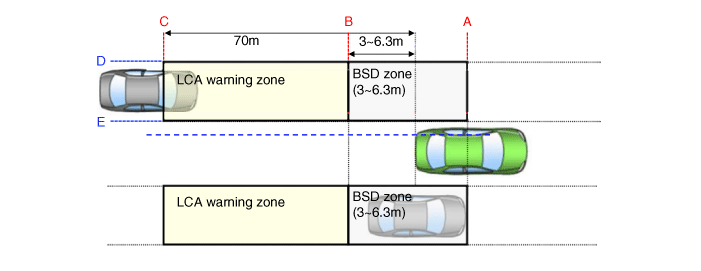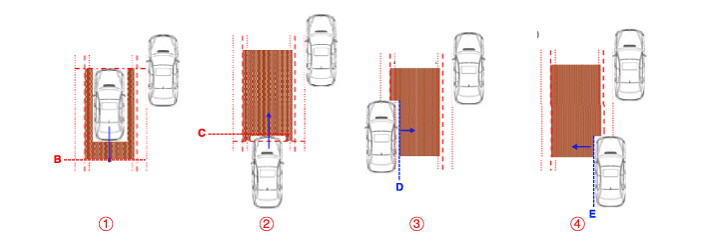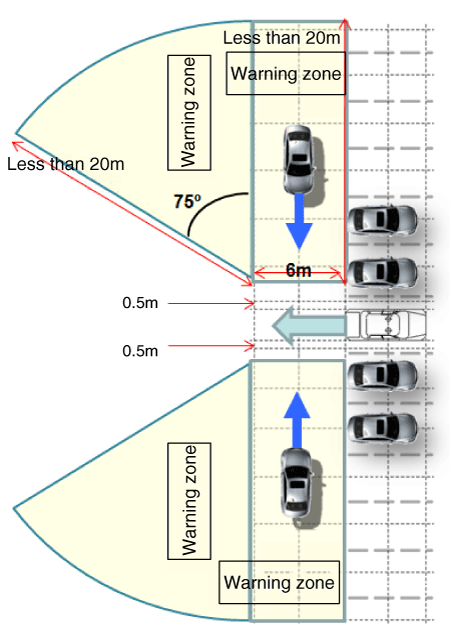Kia Niro: Blind Spot Detection system (BSD) / Description and operation
| Description |
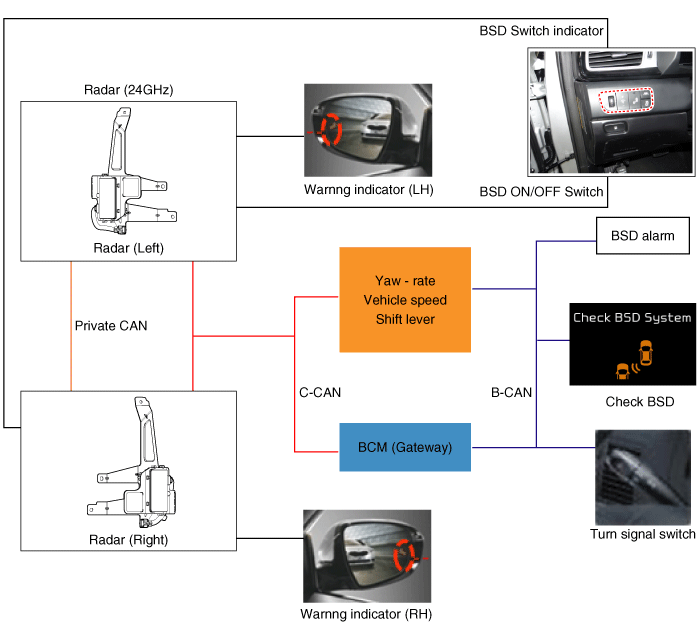
BSD is a system that uses two magnetic wave radar sensors attached on the rear panel to measure the distance from the vehicle in the back and senses and sets off (visual and auditory) alarms for any vehicle coming into the blind spot.
| – |
Blind Spot Detection (BSD) System : Detects other vehicles in the rear blind spot area and warns the driver by indicating on outside rearview mirror. |
| – |
Lane Change Assist (LCA) System : Detects high speed vehicles approaching from rear lateral directions and warns the driver. |
| – |
Rear Cross Traffic Alert (RCTA) System : Sets off warning for vehicles approaching from rear lateral direction when reversing. |

System Operating Mode
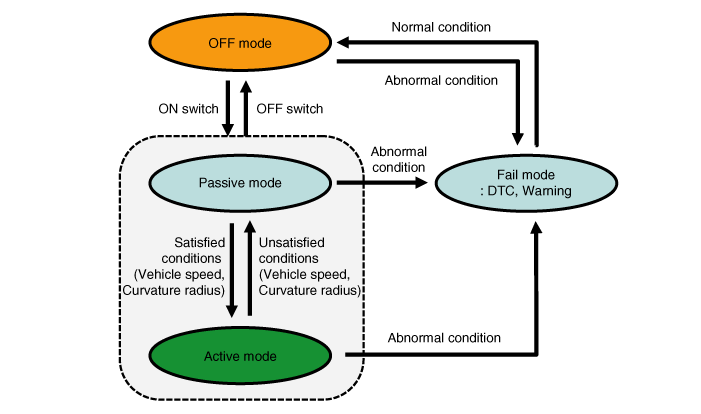
| 1. |
When starting the engine with the switch off, OFF mode is on. |
| 2. |
When pressing ON switch in OFF mode, Passive mode is on. |
| 3. |
If starting the engine with the switch ON, Passive mode is on. ?During IGN ON, the switch is in the initial state: The last position is kept.
|
| 4. |
If you start the engine with BSD switch ON, or if you turn on BSD with BSD switch OFF, the warning lamp of the door mirror flickers for 2 to 3 seconds. This is to inform the driver that the BSD system is ready. (provided that if the system is in Fail mode, there is no flickering.) |
| 5. |
If the activation conditions (speed and curvature radius) are met while driving, Active mode is on (warning issued). |
| 6. |
If the activation conditions (speed and curvature radius) are not met while driving, Passive mode is on (warning removed). |
| 7. |
If BSD & LCA operation fails in any mode, Fail mode is on. |
| 8. |
If BSD & LCA operation operates normally in Fail mode, OFF mode is on. |
| 9. |
If pressing OFF switch while BSD & LCA function is operating (Active/Passive), OFF mode is on. |
Warning Condition
| 1. |
Warning zone
|
| 2. |
Conditions for BSD warning ON ? The entire body of the target vehicle is located behind the line A. ? Any part of the target vehicle passes the line B. ? Any part of the target vehicle passes the line D and Hysteresis In. ? The entire part of the target vehicle passes the line D and Hysteresis In.
|
| 3. |
Conditions for BSD warning OFF ? The entire body of the target vehicle moves before the line A. ? The entire body of the target vehicle moves behind the line B. ? The entire body of the target vehicle passes the line D and Hysteresis Out. ? The entire part of the target vehicle passes the line E and Hysteresis Out.
|
| 4. |
Conditions for LCA warning ON ? The entire body of the target vehicle is located behind the line B. ? Any part of the target vehicle passes the line C. ? Any part of the target vehicle passes the line D and Hysteresis In. ? The entire part of the target vehicle passes the line E and Hysteresis In. ? In the all above conditions, TTC (Time to Collision) is not less than 4.5 seconds.
|
| 5. |
Conditions for LCA warning OFF ? The entire body of the target vehicle is located before the line B. ? The entire body of the target vehicle passes the line C. ? The entire body of the target vehicle passes the line D and Hysteresis Out. ? The entire body of the target vehicle passes the line E and Hysteresis Out. ? In the all above conditions, TTC (Time to Collision) is not more than 4.5 seconds.
|
| 6. |
Sensor activation conditions ? BSD & LCA switch (indicated by the switch LED) is on. ? Vehicle Speed : 30 km/h or faster ? Curvature radius : 125 m or more ? Relative car speed : -10 - 250 km/h (Negative value refers to overtaking the vehicle ahead.) |
| 7. |
Sensor deactivation conditions ? BSD & LCA switch (indicated by the switch LED) is off. ? Vehicle Speed : 28 km/h or slower ? Curvature radius : 125 m or less ? Relative car speed : All except -10 - 250 km/h (Negative value refers to overtaking the vehicle ahead.) |
| 8. |
System control prohibition ? The radar is covered by debris : System conditions - Blockage message is outputted
? The radar installation is distorted due to external impact: Send the error code ? BSD & LCA system fails : Send the error code ? The radar is overheated : System conditions - Over Temperature message is set off.
|
| 9. |
Rear Cross Traffic Alert (RCTA)
? This function helps the driver to detect an approaching vehicle from the rear and side that cannot be visually identified when the driver reverses to pull the vehicle out from a parking spot. ? A warning is generated for the target vehicle if it is within 2 seconds based on TTC (Time to Collision). Pedestrians are not considered as approaching targets when warning the driver. (Warning may not be generated.)
? Warning zone
|
 Components and components location
Components and components location
Components
1. Blind Spot Detection (BSD) Unit
2. BSD switch
3. Speaker
4. BSD warning lamp
5. Cluster
...
 Repair procedures
Repair procedures
Diagnosis With KDS/GDS
1.
BSD system defects can be quickly diagnosed with the KDS/GDS. GDS operates
actuator quickly to monitor, input/output value and self diagnosis. ...
Other information:
Kia Niro 2017 (DE HEV) Service Manual: Description and operation
Operation
1. Cooling Fan
2. cooling duct (inlet)
3. outlet cooling duct (outlet)
...
Kia Niro (DE HEV) Owners Manual: FM reception
AM and FM radio signals are broadcast from transmitter towers located around
your city. They are intercepted by the radio antenna on your vehicle. This signal
is then received by the radio and sent to your vehicle speakers.
When a strong radio signal has reached your vehicle, the precise engi ...

